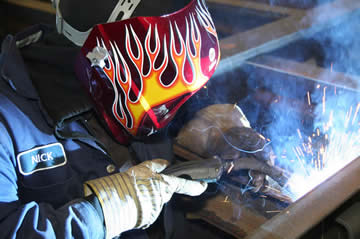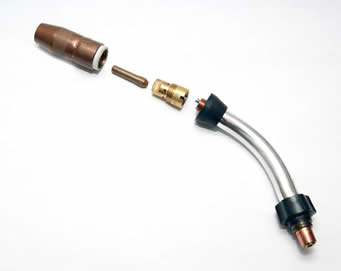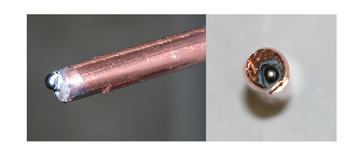Don’t Let Consumables Consume Your Profits: Choose, Use and Troubleshoot Wisely

It doesn’t take much to create a MIG weld. All you really need is a power source, some CO2, a MIG gun, ground cable and a wire electrode.
Of course, that doesn’t mean you’ll end up with a mechanically sound or decent looking weld. Achieving those results requires a strong skill set, close attention to detail and the right MIG welding consumables (among other things, of course).
Often overlooked during the purchasing process MIG gun consumables — the contact tip, nozzle and diffuser — are the decisive variables in electrical transfer to the wire and shielding gas to the weld pool. No matter how well tuned the rest of your welding equipment is to your application, without the right consumables in properly functioning order, your weld quality will suffer.
Obtaining high quality welds and high productivity rates requires attention to the type of consumables you purchase, how they are installed and used by your welding operators and accurately troubleshooting consumables problems when they arise.
Choose Wisely
Selecting high quality consumables is paramount to obtaining high quality welds and avoiding unnecessary downtime.

High quality consumables provide better shielding gas coverage of the weld, resulting in less porosity and a more stable arc, as well as longer contact tip and nozzle life, reduced burnbacks and fewer weld defects caused by loose consumables fittings. With labor accounting for roughly 85 percent of a welding operation’s expenses, the slightly higher cost of high quality consumables can quickly be offset by these advantages.
Another labor-related factor to consider when selecting consumables is the time it takes to change contact tips. A non-threaded contact tip that can be changed by dropping it into the diffuser, without tools, and locking it in place via the nozzle can often cut changeover time in half.
Further, consumables systems that can be mounted to a wide variety of gun brands reduce the time it takes to locate a replacement tip and reduces the inventory footprint and time spent monitoring and ordering new product.
Equally important is choosing the right consumables for the application. For example, using heavy-duty nozzles, with thick-walls as well as wide nozzle bores, will only add weight and reduce weld pool visibility in low-amperage, thin-gauge applications. Likewise, using thin-walled brass nozzles with narrow nozzle openings in heavy-duty applications could result in inadequate shielding gas coverage, frequent burnbacks and
Use Wisely
MIG gun consumables are exposed to more heat and mechanical stress than any other component in your MIG welding system, so even the best consumables you can buy will wear out and need to be replaced on a regular basis. While this can’t be avoided, correctly using the consumables can lengthen their service life and improve weld quality.
Maintaining the correct contact tip stick out or recess, as it relates to the end of the nozzle, is crucial to ensuring good weld results. The amount that a contact tip is recessed or extended past the nozzle determines the wire stick-out and how much heat from the arc the contact tip absorbs. High current, high heat applications generally require a contact tip recessed up to 1/4” from the end of the nozzle. Lower amperage applications, or those with narrow joint configuration, might require a flush or extended contact tip.
Contact tips are available either as adjustable or with a fixed recess. Adjustable recess contact tips allow you to simply raise or lower the contact tip to your liking, but they also increase the potential for human error, particularly in welding operations where multiple operators use the same gun. Fixed recess contact tips need to be changed when changing to a different application, but they standardize the weld process and eliminate a variable that can affect welding performance. Below is a chart showing the recommended tip recesses for a variety of applications and processes.
Regularly inspecting, cleaning and adjusting the consumables is also critical to ensuring weld quality. A nozzle that becomes clogged by spatter can restrict shielding gas flow and lead to porosity. You can use a welder’s pliers or a nozzle reamer to clear out any spatter that builds up. Likewise, the contact tip can develop an oval shaped bore, called keyholing, from the welding wire passing through it, which can cause interruptions in electrical current to the wire, resulting in an unstable arc, porosity and other problems. Some brands of contact tips can be rotated to provide additional contact surface when the wire wears out a portion of the bore.
Troubleshoot Wisely
Unfortunately, no amount of deliberation and careful use can completely eliminate problems from occurring. Being able to quickly and accurately troubleshoot problems when they do occur, however, can reduce the impact of the problem and the downtime that you incur. Generally speaking, the best way to troubleshoot a problem is to use the process of elimination to move from the least to the most time consuming equipment to check.

Contact tip burnback, where the welding wire fuses to the contact tip, occurs occasionally if the tip gets too close to the weld pool, but it could also indicate an equipment problem if it occurs frequently or happens when the contact tip is not too close to the weld pool. Some common sources of contact tip burnback are: incorrect contact tip recess, a faulty work lead or ground, and erratic wire feeding (discussed below).
Erratic wire feeding is usually caused by an obstruction or kink in your liner, incorrect or improperly tensioned drive rolls or a worn out or wrong sized contact tip. If this problem is encountered, inspect the contact tip, then check the drive rolls and finally remove and inspect the liner if the first two items are functioning properly. Replace any of these items that appear worn or damaged.
An erratic arc can be caused by erratic wire feed, but is most commonly a result of inconsistent electric current being delivered to the wire. A gun neck that is too straight or a worn out contact tip are common sources of an erratic arc. If the contact tip appears in good working order and the neck is at least a 30 degree bend, check the electrical connections between the components to ensure they are tight and free of debris.
Spatter is a common occurrence in MIG welding, but excessive spatter could signal an equipment malfunction. Either too much or too little shielding gas flow as well as an improperly installed contact tip are common causes of excessive spatter. Try adjusting these components first, before moving on to other possible causes.
Porosity — small holes in the weld bead — is another common outcome of too much or too little shielding gas. Begin troubleshooting porosity by checking that the nozzle is not clogged by spatter. If the nozzle is clear, move on to check that the gas ports are not blocked by an obstruction, that the solenoid is working properly and that the o-rings at the back end of the MIG gun are not damaged. Also check the electrical connections at the MIG gun, ground clamp and consumables to make sure they are providing good electrical transfer.
Although some troubleshooting can’t be avoided, you can greatly reduce your downtime spent changing contact tips and troubleshooting weld defects by carefully choosing your MIG gun consumables and carrying out a regular inspection and maintenance schedule.
Laying down a strong, great looking MIG weld is no easy task, but doing so with poor quality or improperly configured equipment is virtually impossible. The little time you spend researching, choosing and maintaining your equipment will save you a considerable amount of time, and headaches, down the road.


